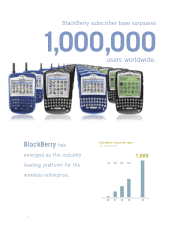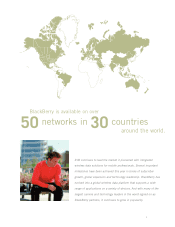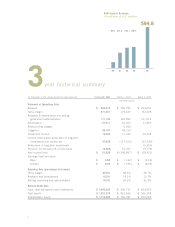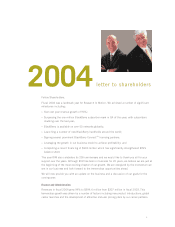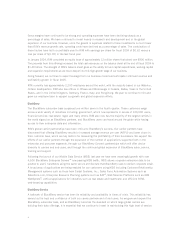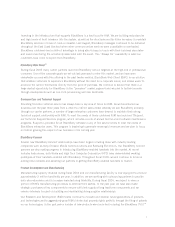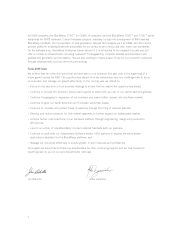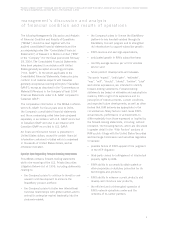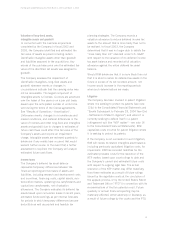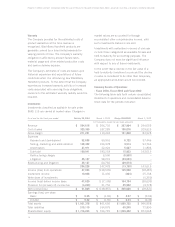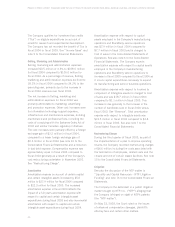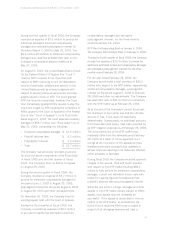Blackberry 2004 Annual Report Download - page 14
Download and view the complete annual report
Please find page 14 of the 2004 Blackberry annual report below. You can navigate through the pages in the report by either clicking on the pages listed below, or by using the keyword search tool below to find specific information within the annual report.
12
Research In Motion Limited • Incorporated Under the Laws of Ontario (In thousands of United States dollars, except per share data, and except as otherwise indicated)
If the historical data the Company uses to estimate
product returns does not properly reflect future
returns, these estimates could be revised. Future
returns, if they were higher than estimated, would
result in a reduction of revenue.
Service
Revenue is recognized rateably on a monthly basis
when the service is provided. In instances where the
Company bills the customer prior to performing the
service, the prepayment is recorded as deferred
revenue.
Software
Revenue from licensed software is recognized at the
inception of the license term and in accordance
with SOP 97-2. Revenue from software
maintenance, unspecified upgrades and technical
support contracts is recognized over the period that
such items are delivered or that services are
provided.
Other
Revenue from the sale of OEM radios and
accessories is recognized when title is transferred
to the customer and all significant contractual
obligations that affect the customer’s final
acceptance have been fulfilled. Provisions are made
at the time of sale for applicable warranties,
royalties and estimated product returns. Technical
support contracts extending beyond the current
period are recorded as deferred revenue. Revenue
for non-recurring engineering contracts is recognized
as specific contract milestones are met. The
attainment of milestones approximates actual
performance.
Allowance for Doubtful Accounts
and Bad Debt Expense
The Company evaluates the collectibility of its trade
receivables based upon a combination of factors.
RIM regularly reviews and updates its information
with respect to significant receivable balances. RIM
has historically been dependent on a small but
increasing number of significant customers and on
large complex contracts with respect to sales of the
majority of its products. The Company expects this
trend of increasing trade receivables balances with
its large customers to continue as it sells an
increasing number of its products and service relay
access through network carriers and resellers rather
than directly.
When the Company becomes aware of a specific
customer’s inability to meet its financial obligations
to the Company, (such as in the case of bankruptcy
filings or material deterioration in the customer’s
operating results or financial position, payment
experiences and existence of credit risk insurance),
RIM records a specific bad debt provision to reduce
the customer’s related trade receivable to its
estimated net realizable value. If circumstances
related to specific customers change, the Company’s
estimates of the recoverability of trade receivables
could be further adjusted.
Inventory
Raw materials are stated at the lower of cost and
replacement cost. Work in process and finished
goods inventories are stated at the lower of cost and
net realizable value. Cost includes the cost of
materials plus direct labor applied to the product
and the applicable share of manufacturing overhead.
Cost is determined on a first-in-first-out basis.
The Company’s policy for the valuation of inventory,
including the determination of obsolete or excess
inventory, requires management to estimate the
future demand for the Company’s products within
specific time horizons. Inventory purchases and
purchase commitments are based upon such
forecasts of future demand and scheduled rollout of
new products. The business environment in which
RIM operates is subject to rapid changes in
technology and customer demand. The Company
performs a detailed assessment of inventory each
reporting period, which includes a review of, among
other factors, demand requirements, component
part purchase commitments, product life cycle and
development plans, component cost trends, product
pricing and quality issues. If customer demand
subsequently differs from the Company’s forecasts,
requirements for inventory write-offs that differ from
the Company’s estimates could become necessary. If
management believes that demand no longer allows
the Company to sell inventories above cost or at all,
such inventory is written down to net realizable
value or excess inventory is written off.


